How Often Should Hood Filters Be Cleaned
How to Cull the Right Range Hood
Learn about the many range hoods available. Determining factors that will lead you to an informed determination: efficiency, noise level, color and mode, lighting and maintenance requirements. Here is a guide that volition help you brand the correct choice.
Extraction or recirculating organization
1 of the first criteria to consider when yous select a range hood is the ventilation system. There are 2 master types of hoods: ducted and ductless.
A ducted hood is the all-time option. Notwithstanding, if information technology is not possible to install ductwork to draw foul air outside, you need to turn to a recirculating hood.
Ductless Hoods - Recirculating
This type of hood operates as follows: a charcoal filter cleans foul air, removes nigh grease particles and odours and returns the air to the kitchen.
Ductless hoods are simpler to install just are considered less constructive than ducted hoods, since they return air back into the kitchen without extracting smoke, oestrus or wet.
Ducted Hoods - Extraction
This blazon of hood completely eliminates foul air, venting it exterior the firm through ductwork. These hoods are very popular and establish the about effective way of meeting ventilation standards as set out in the National Building Code of Canada. Installing a ducted range hood is more complicated considering of the ductwork involved; once that is in place, installation of the hood is quickly completed.
v chief models: brief overview
To be effective, the hood should be positioned above or very close to the cooktop. It is therefore the location of your cooktop that will determine the hood model y'all should install.
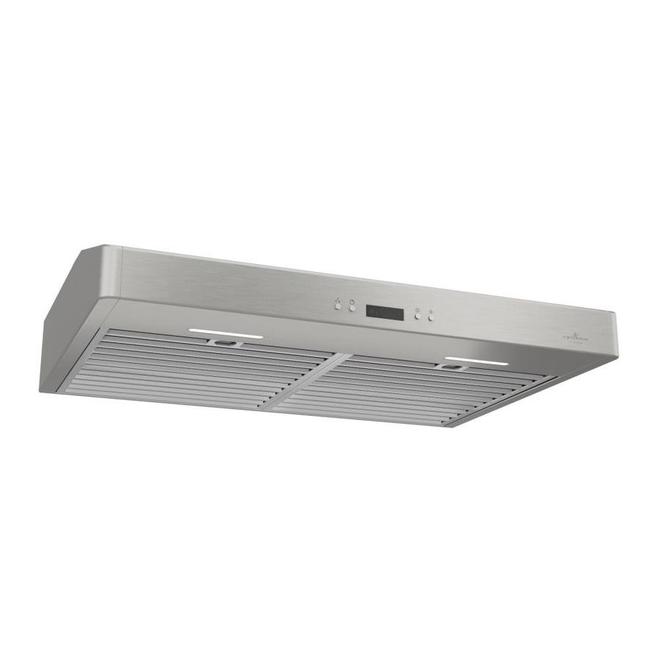
Standard Hood
These range hoods are by far the most popular. They tin can be vented outside through ductwork or ductless. They are installed under the cabinets that agree them in identify.
Shop at present

Chimney-Style Hood
This designer model is fast gaining in popularity. Wall-mount hoods are installed directly on the wall and are usually ducted. When venting through ducts is not viable, at that place are models available with a recirculation system.
Store now
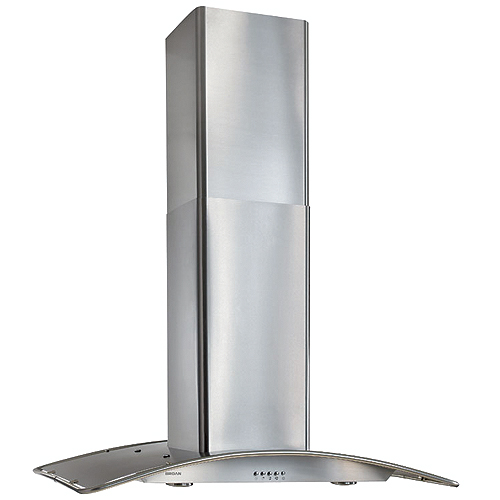
Island Range Hood
This hood model is suspended above a kitchen island or peninsula and includes a chimney which tin can be adjusted according to the height of the ceiling. The fan can be either internal or external and vented through ductwork. This type of range hood creates more air movement. It is therefore important to correctly evaluate the power of this type of hood.
Shop now
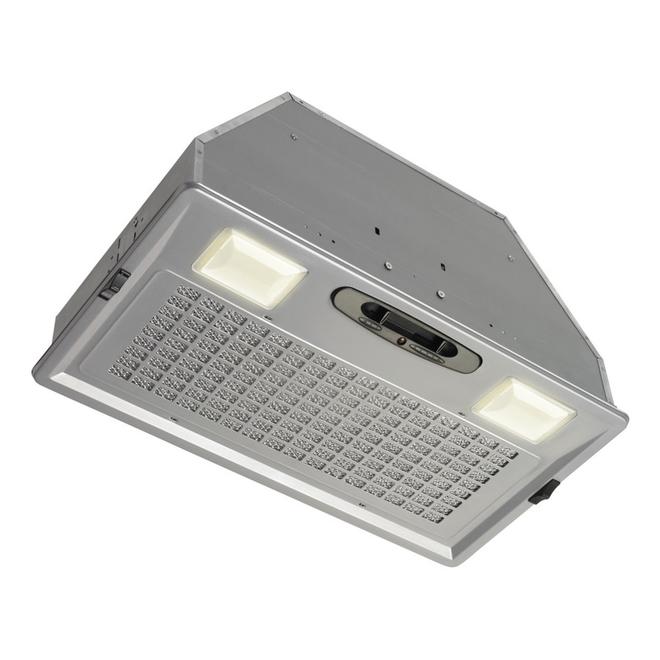
Built-In Hood
A congenital-in hood is designed to be installed in a custom-built cabinet. The ventilation module can be installed inside (internal module) or on the outside (external module). Models with exterior ventilation modules are quieter. Built-in hoods offer loftier-performance with a ventilation capacity of between 600 and 1200 CFM.
Shop now
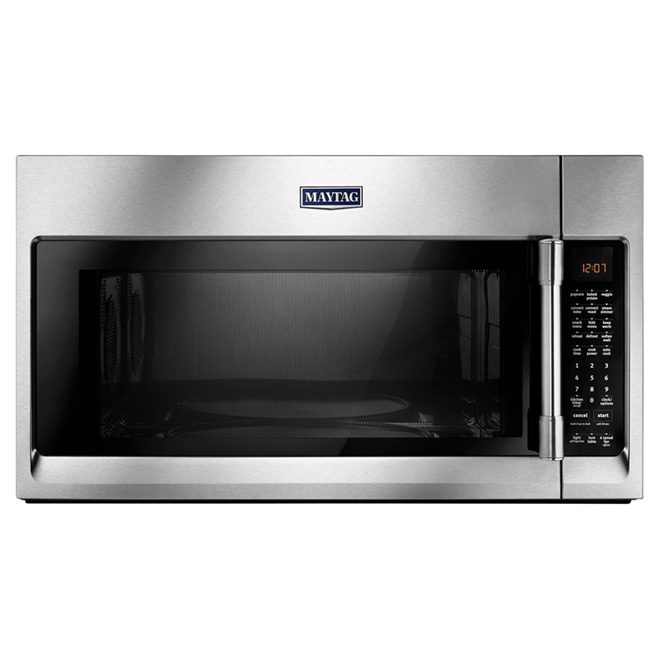
Microwave with Integrated Hood
This type of inhaling hood takes up less space in the kitchen than about other hood models.
Shop now
Let's not forget specialized models
Downdraft Range Hoods
Downdraft range hoods are located at the side or behind the cooking expanse and level with the cooking surface. These models, practical because they are inconspicuous, require an internal or external vent.
They can be less constructive than other types of hoods, since heat and foul air tend to ascent, and, in certain cases, ventilation modules are besides far away from some cooktop elements.
Slide-Out Range Hoods
These models are installed under a full-size kitchen chiffonier with either outside venting or a recirculating charcoal filter.
FEATURES AND COMPONENTS
-
Sizing
The width of about range hoods varies between 24 and 36". xxx" models are the most popular since their width conforms to the width of near electric and gas stoves. As a general rule, the range hood should overlap the cooking surface past three inches on both sides. This is specially important for gas ranges.
Depth can vary slightly from one manufacturer to some other and from one model to another. Hood depth should generally exist calculated to overhang at least a half of the front elements.
-
Motor Power
Range hoods are equipped with electric motors called according to the air movement information technology produces. This chapters is measured in cubic feet per minute (CFM).
This measurement, which only applies to outside venting systems. When you calculate chapters, you should accept kitchen volume and duct length into consideration. If you have an open-concept kitchen, you need to calculate the total book. The hood should be capable of achieving x to 12 air changes per hour to fairly excerpt odours and fumes.
To calculate the required capacity, multiply the superlative (H) of the kitchen by its area (W x D), which will requite y'all the volume of the room. Multiply this number past ten and the outcome is expressed in m3/h.
For instance, in a room measuring 15m2 and 3m high, a hood with 450m3/h motor power should be installed.
Yous should also take duct length into account. A long duct with several 900 elbows requires extra ventilation capacity. The following table will let you to evaluate minimum capacity requirements according to duct length:
Duct length CFM Capacity
ane' to 15': Upwards to 270 CFM
16' to 20': 270 to 400 CFM
20' and more: 400 CFM or more -
Lighting
Most range hoods are equipped with ane or more lights which provide an extra source of lighting in the kitchen. Depending on the model chosen, you may have up to three incandescent, fluorescent or element of group vii bulbs. A few models include LED lighting, which is heat sensitive and generally not recommended.
-
Fans
Fans are fabricated of plastic or metal and are generally located in the torso of the range hood, making them easier to access for cleaning and maintenance, just besides noisier.
If y'all want to eliminate every bit much noise as possible, you lot should consider range hoods with fans placed exterior the house. For this blazon of installation, intended solely for external venting hoods, the fan/motor casing is located in either the attic or roof space. Although a petty more complex, this type of installation is much quieter. Motors are equipped with i of two types of fans, either:
- a propeller fan, with blades that move the air somewhat like the propeller of a plane, or;
- a centrifugal or blower fan, which resembles a hamster bike, powered by a rotating cylinder with straight blades. This blazon of fan is more efficient and quieter than the propeller fan.
When noise is a prime consideration, bank check out models equipped with in-line fans or fans placed outside the habitation. -
Filters
The master function of filters is to capture grease particles before they enter the ducting. Grease represents a potential burn take chances and can also present long-term cleaning problems. Rectangular or circular, filters come in diverse sizes depending on the hood model. Some models use 2 filters.
Aluminum filters: Metallic mesh filters or fine mesh filters are the most widely used. They tin can be removed hands, washed in the dishwasher and are therefore reusable. Where they are available, fine-mesh aluminum filters are recommended.
Baffle filters: These commercial-mode filters are made of stainless steel and placed within the casing. More durable than aluminum filters, they cover the entire surface under the hood and can be washed in the dishwasher.
Charcoal filters: Charcoal filters and charcoal filter modules are used for ductless hoods. They eliminate cooking odours and capture grease. They are mainly modules that are inserted in the hood; they are rarely interchangeable betwixt hood models, except possibly between models from the same manufacturer. They cannot be washed and must be replaced regularly.
-
Hood Torso
The hood body houses the various elements included in the hood, such as the filters, fan and motor.
Other Features
Some hoods characteristic electronic affect controls for automatic shutoff functions and heat sensors that automatically increment fan speed and sound an alert if things go likewise hot.
Sure models are equipped with an electronic sensor which will automatically actuate the hood when fume is detected. The intensity of the smoke in the air determines the suction power of the hood which will also plow off automatically.
Hoods with perimeter suction have recently come on the market; originally adult for commercial purposes, they capture peripheral odours and smoke very effectively.
Finally, the Heat SentryTM detector automatically adjusts the ventilation setting if the heat detected from the stovetop is besides high.
Installation: how it's done
Once the ventilation ducts are in place, the installation of the range hood is relatively simple. The top, or the distance between the range and range hood, varies according to the type of cooktop, suction and exhaust chapters, and the blazon of unit. As a general rule, the closer the hood is to the cooking surface, the more than effective the suction and evacuation of foul air will exist.
Lower-performing hoods should exist installed xviii" to 24" from the cooktop.
Boilerplate-performing hoods should exist installed 24" to thirty" from the cooktop.
Top-performing and commercial-type hoods should be positioned 30" to 36" from the cooktop.
These are full general guidelines and will vary co-ordinate to private manufacturers. Be sure to read the instructions carefully.
-
The location of the exhaust opening may vary from i manufacturer to another.
-
The circumference of the ducting must be the aforementioned or greater than that of the connection located on the hood.
-
A range hood should be installed a minimum of xx" in a higher place an electric unit and 30" above a gas range. For optimum efficiency, the altitude between the cooking surface and hood should not exceed 30".
-
Make the ductwork run every bit brusque and as direct as possible and with equally few turns as possible. When this is not possible, retrieve that 45° angles allow for improve air circulation than xc° angles. Don't forget to finish with a roof cap or wall cap.
-
With vi" round ducting, install a transition piece and seal joints with ii" duct tape. The wall duct should exist prepared for the adaptor that should be inserted hands into the duct.
-
Never terminate venting into an cranium. Backlog moisture will damage wood structures and drywall. Furthermore, expelled cooking grease can create a fire hazard and will attract unwanted insects. You should as well keep safety in heed when placing and choosing kitchen cabinets.
-
E'er use rigid steel ducts. Flexible duct piping or corrugated metal are more decumbent to grease build-upward, which can nowadays a burn down risk.
Any installation method you lot choose, it is generally wise to consult an electrician. If yous determine to practice the installation yourself and to connect the range hood to an existing electrical excursion, remember the xv- amp rule, whereby the total load on whatsoever circuit billow may not exceed fifteen amps. If the range hood's additional amperage plus existing elements (other appliances, lights, etc.) totals more than than 15 amps, you'll need to wire information technology into an empty breaker slot in the primary panel.
The optimum amperage (calorie-free and fan speed settings) will be indicated on a label attached to the hood. The Building Code requires that you install a junction box at every wire junction.
Retrieve that all electrical installations in Quebec must exist carried out by a primary electrician and member of the Corporation des maîtres électriciens du Québec (CMEQ). Then continue these factors in mind when planning your kitchen renovation.
A few maintenance tips
Earlier purchasing, run your hand lightly on the underside of the hood to brand sure there are no crude or sharp edges that could crusade any injuries when yous're cleaning. Grease and soot accumulate in the filters, on the underside of the hood and on ducts. If yous allow filters become obstructed, their effectiveness volition be compromised.
Maintenance should exist carried out as follows:
-
Soak aluminum mesh filters in soapy water or put them in the dishwasher to break downwardly accumulated grease;
-
Clean all surfaces with a mild dish soap, and at least once a month;
-
Supplant charcoal filters 2 to 4 times per yr depending on how often the hood is used;
-
Make clean the fan blades. In many centrifugal fan models, these easy-to-remove blades can be put in the dishwasher.
Source: https://www.rona.ca/en/workshop/guides/choosing-range-hood
Posted by: santoseache1999.blogspot.com

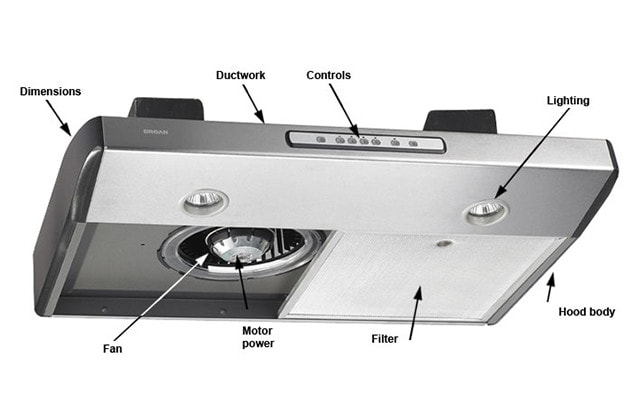


0 Response to "How Often Should Hood Filters Be Cleaned"
Post a Comment